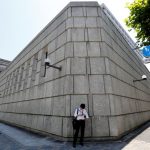
TOKYO (Reuters) -Bank of Japan policymakers discussed in January the likelihood of a near-term exit from negative interest rates and possible scenarios for phasing out the bank’s massive stimulus programme, a summary of opinions at the meeting showed on Wednesday.
The summary highlights a growing view within the board that conditions were falling in place to soon pull short-term interest rates out of negative territory, which would be Japan’s first interest rate hike since 2007.
“It seems that conditions for policy revision, including the termination of our negative interest rate policy, are being met,” one member was quoted as saying in the summary.
Another opinion called for the BOJ to end negative rates “at an appropriate timing,” as delaying the decision for too long could require subsequent interest rate hikes to be rapid, the summary showed.
The BOJ should also end purchases of risky assets such as exchange-traded funds (ETF) once sustainable achievement of its 2% inflation target comes into sight, a third opinion showed.
Some analysts saw the hawkish tone of the summary as a sign the BOJ could end negative rates at its next meeting in March.
“It appears as if the countdown toward a policy shift has begun,” said Ryutaro Kono, chief Japan economist at BNP Paribas (OTC:BNPQY).
“The balance of views within the board has tilted quite clearly toward an early policy shift. It won’t be surprising for the BOJ to end (negative rates) at its next meeting,” he said.
Under its massive stimulus programme, the BOJ guides short-term interest rates at -0.1% and the 10-year bond yield around 0%. It also buys government bonds and risky assets as part of efforts to reflate growth and achieve its 2% inflation target.
With inflation having exceeded the BOJ’s target for well over a year, many market players expect the central bank to end negative rates either in March or April.
At the Jan. 22-23 meeting, the BOJ maintained ultra-loose policy but Governor Kazuo Ueda signalled the bank’s growing conviction that conditions for phasing out stimulus were falling into place. He also said the BOJ will likely keep monetary conditions ultra-loose even after ending negative rates.
In a sign the board was already brainstorming ideas on how to dismantle the BOJ’s complex stimulus framework, one member said the bank should first revise measures with the largest side-effects, without specifying what they were.
When debating an end to bond yield control and negative rates, the BOJ must also examine the fate of a pledge to keep increasing the pace of money printing “until inflation stably exceeds 2%,” another opinion showed.
“Since achievement of our price goal has become more likely, it’s necessary to start full-fledged discussions on an exit,” one member said.
Japan has remained a dovish outlier among major central banks that tightened monetary policy aggressively last year to combat soaring inflation.
If the BOJ were to raise short-term rates this year, it could coincide with possible interest rate cuts by the U.S. Federal Reserve and the European Central Bank.
Some analysts warned the BOJ risks triggering a sharp yen rebound and hurting its export-reliant economy, by swimming against the global tide toward lower borrowing costs.
“Now is the golden opportunity” to change policy as “shifts in overseas central banks’ monetary policies could reduce the BOJ’s policy flexibility,” one opinion said, a sign the BOJ was mindful of the fallout from its counterparts’ rate cut timing.
The summary of opinions does not disclose the identities of the board members who made the comments.
To read the full article, Click Here

